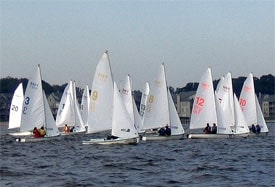
BHall1012
Fluctuating conditions at Navy this weekend tested the fleet of top east coast women’s teams that competed in the annual Navy Fall Women’s Intersectional. The breeze on Saturday was a light southerly that, combined with the choppy conditions that are often present at Navy, made it difficult to maintain boat speed and stay in the groove. Sunday’s puffy and shifty breeze, out of a north to northwesterly direction, highlighted a team’s ability to shift gears. As is always the case with Navy’s big fall intersectionals, the best teams were able to sail each of three different boats well. The regatta used 420s, Club Juniors and Laser Radials, with 13 of the 20 schools fielding a full squad, while the remaining seven just sailed the doublehanded divisions. The College of Charleston women had consistent finishes in all three divisions, clinching a first-place finish. Juniors Alana O’Reilly and Suzy Lintern finished second in A division, only two points out of first. Seniors Sara Wilkinson and Kelley Bowers finished third in B division while Anne Bowen, also a senior, was second in C division. No other team was able to post more than one top-three finish. In two of the three divisions, there were dominant winners. Brown sophomore Katie Lovelace with senior crew Louise Sherman beat Georgetown freshmen Blaire Herron with senior crew Dorothée Bergin by 17 points to win B Division while St. Mary’s junior Jenny Gervais won the Laser Radial group by 35 points. In A Division, however, the race was extremely tight among the top three boats, with just three points separating first from third. Yale junior Molly Carapiet with senior crew Jenn Hoyle were able to edge the Charleston women to secure first in A division, with ODU seniors Anna Tunnicliffe and Christabelle Fernandez, finishing third. When asked how she was able to deal with the shifty conditions to secure a victory in A division for her team, Carapiet said that the key was to “be patient, wait for the shifts and keep the boat moving”. Tunnicliff added that the key to sailing in Navy’s challenging conditions was “just trying to find the puffs and pressure.” While there are many up-and-coming women’s sailors competing this year, the tight racing in A Division shows that experience is still a huge factor in determining the outcome of these big intersectional events. Fluid transitioning between the CJs and C420s and shifting gears in the fluctuating breeze are essential skills for posting consistent finishes.









